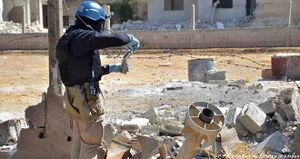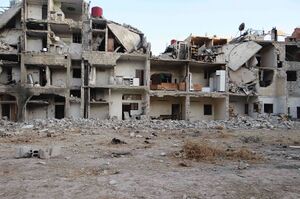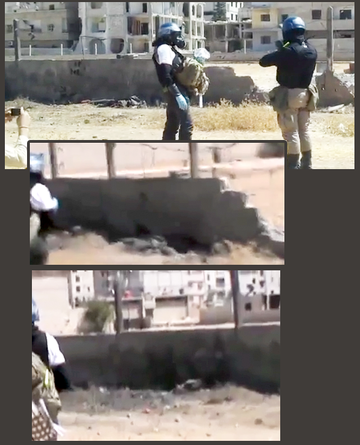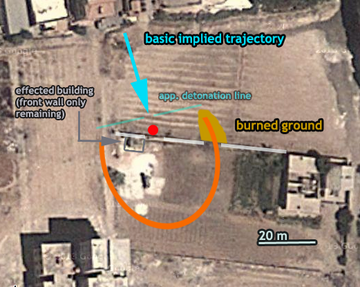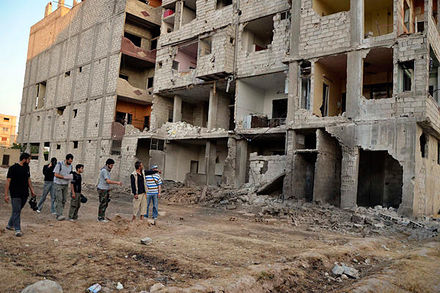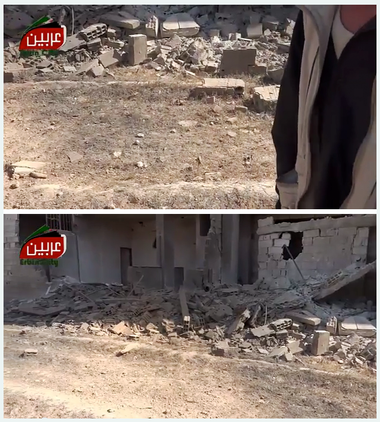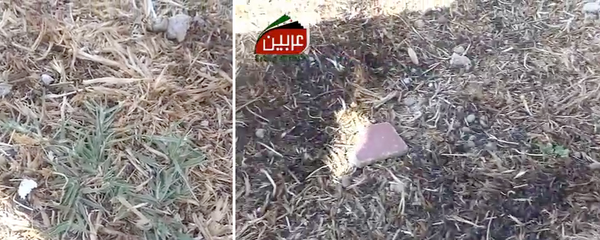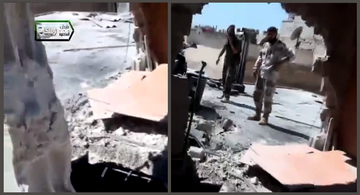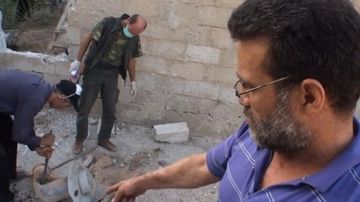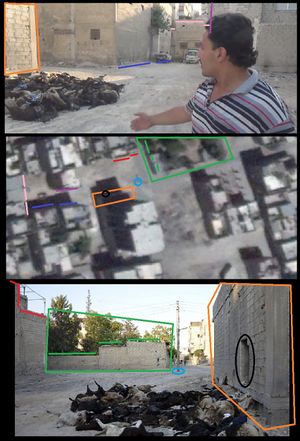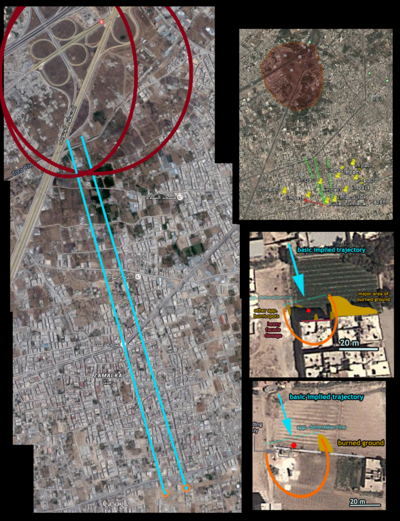Talk:Thermobaric weapons
< Talk:Alleged Chemical Attack, August 21, 2013
The central link between the chemical deaths of August 21 and the Syrian military is a certain model of rocket, allegedly fired by them in some number into the rebel-held districts. Dubbed by Eliot Higgins (aka Brown Moses) and others UMLACA (Unknown Munition Linked to Alleged Chemical Attacks), it has an unusual design with a fat tank with a 60-liter capacity in the middle, apparently made in Syria and unknown to arms experts. There are two variants, as Higgins reasonably describes: black-lettered for the high explosive version (dubbed UMLACA-HE), and a red numbered "unknown" (UMLACA-UK). The latter are the type credited by local opposition as the delivery vehicle for unknown chemical agents, and two at least have tested positive for Sarin and/or by-products by the UN's investigative team.
The possibility of the UMLACA's design for use as a fuel-air / thermobaric weapon is widely noted, presumably adapted to deliver Sarin instead. But there are some very strong signs they were used as a fuel-air explosive, in the exact instances that matter, where CW dispersal was alleged. These signs have been noted by some commentators but ignored or unduly downplayed by many more (like Higgins). Any such use would be fatal to the claims that they also dispersed the Sarin, vaporizing to oblivion any that was put there. That in turn would raise grave questions about how traces of Sarin turned up on the rockets, and inside local people brought forth by rocket-blaming rebels.
The possibility needs to be addressed and either dismissed or clarified as the central clue it is. Either way, these rockets are a smoking gun, which someone put Sarin on or in. It's crucial to get the best reading on which way the blame points. Luckily, the answers are in the realm of pretty hard science; so as long as politics or ignorance doesn't interfere, the visuals, other reliable evidence, and known facts of the chemicals and processes should be able to be pinned down (with the right effort, in time). --Caustic Logic (talk) 06:57, 29 September 2013 (UTC) and --Caustic Logic (talk) 10:49, 1 October 2013 (UTC)
FAE/Thermobaric Weapon Basics
To help understand the type of weapon we think these could be, eventually we'll have the most relevant points explained out here. Until then, see Wikipedia: Thermobaric weapon. In super short, it disperses fuel droplets into the air and then ignites them, creating a giant fireball and massive inverse pressure wave. Either the fire or this wider wave can kill people (sucks the air from lungs, crushes organs), and it can suck the walls off buildings, collapse tunnels, etc. In recent uses especially around Aleppo, rebels often refer to these as "vacuum bomb." They are considered controversial weapons, heavily used by the United States in both Afghanistan and Iraq.--Caustic Logic (talk) 13:00, 6 October 2013 (UTC)
Thermobaric (heat-pressure) can mean the general class of weapons, but also seems to refer to a more advanced and recent form of the FAE bomb, pioneered for use in Afghanistan in 2001. (Discover Channel video) --Caustic Logic (talk) 13:00, 6 October 2013 (UTC)
Some have claimed FAE/thermobaric bombs can only be delivered by airplane, proving for example the government had to behind the late September 2013 FAE attack on a fully occupied secondary school near Raqqah (see below). Sadly, there are a number of way to deliver FAE/thermobaric weapons of different sizes and styles that are within reach of either side, and surface-fired. Consider the U.S.-made SLUFAE (surface launch unit fuel-air explosive). It looks just like a cousin our our UMLACA here. --Caustic Logic (talk) 13:00, 6 October 2013 (UTC)
There is a difference between a proper detonation and a deflagration. Some signs suggest, I think, that the latter happened in the two outside Zamalka instances. More informed comments on that would help here. --Caustic Logic (talk) 13:00, 6 October 2013 (UTC)
Was not following this discussion but this UR-77 Mine Clearing line charge vehicle, --a rocket launched fuel/explosive hose,--- is shown here at work in Syria. Might be more appropriate tool. It has similarities with thermobars and might be called as such. Another video with UR 77. There is simpler, portable version UR 83 --Resup (talk) 01:06, 14 January 2015 (UTC)
General Discussion Towards Consensus
I'd like to put this up top. I'm no scientist or weapons expert, but I feel like Asheville, they guy who first pushed the notion of the UMLACA as FAE, is really onto something. Looking at the scenes, it continues to make sense and clarifies - I can see a fireball area about 30 meters wide, which I hear is about what you'd expect from about 60 liters of the standard fuel, which is about the UMLACA's evident capacity. (see below). But I've been wrong before and I'd like to hear more from anyone else who might be more qualified than me. Is the stuff I'm assembling below on a fruitful track, or is there a misunderstanding and yet another false lead? --Caustic Logic (talk) 14:31, 30 September 2013 (UTC)
Important questions:
- From what we here know about Sarin and about fuel-air explosives, how much sense does it make to use one rocket as both? There are signs pointing both ways, so it a giant fireball and pressure wave a plausible means of spreading Sarin gas/vapor to kill any number of people? Or is it pretty much an either-or situation? --Caustic Logic (talk) 14:31, 30 September 2013 (UTC)
- Either one, not both in the same rocket. The explosion would burn and destroy the sarin. The design may be adapted to both uses, although there may be little point in deploying sarin in 6 liter canisters. -- Petri Krohn (talk) 15:15, 30 September 2013 (UTC)
- That's what I was thinking, but I like to get more details and/or agreement before pushing on. --Caustic Logic (talk) 23:38, 30 September 2013 (UTC)
Signs of war damage in Eastern Ghouta
For the record: I find this angle to be so implausible that I can't even exactly tell you why because I didn't follow. When I look at the scenes I see the result of two years of fighting and no possibility to even guess which part of any damage is due to anything happening on August 21. IF the identification of the UMLACA as that US design is really waterproof, it might be useful as an indicator that the black op group which got it planted there as a false lead must have had access to it. That's the most use I can see here, don't see how it possibly fits with the rest of what we know about the event(s). --CE (talk) 15:59, 30 September 2013 (UTC)
- Some skepticism, good. It's supposed to be implausible, using both at once; it must be one or the other. As for dates, screw those. But for these rocket strikes on whatever day, not 100% provable but I think the scorching about 30 meters around each strike and major wall collapses nearby are connected to the thing n the middle of that. And if it wasn't FAE, it might be chemical, or else empty (?) Sasa wawa said there's burnt stuff all over, it's war and you can't connect things, so let's be more open-minded than that anyway. The point is not who made it but how it works. It would cook off any Sarin therein. Sarin on it, and in surrounding blood, almost must be planted, if these rockets were used as FAE. That's how it's looking to me, and it's crucial. --Caustic Logic (talk) 23:38, 30 September 2013 (UTC)
- Put another way: you said you see "no possibility to even guess which part of any damage is due to anything on August 21" (or in particular). There is no way to be sure, considering. But still if the same things pop up at least twice (as it does, 75 meters apart, and in other spots too), and that fits with something logical, like the apparent FAE design of the thing, etc ... that's a good time to venture a guess that might explain it all (except the CW parts). I feel like as soon as you follow, you'll be excited, but still skeptical, hopefully. --Caustic Logic (talk) 10:49, 1 October 2013 (UTC)
- I do not see the signs of two years of fighting. In fact I do not see any signs of fighting in the effected areas. There are no bullet holes or holes left by shrapnel. These collapsed walls are an oddity. Where we are starting to see fighting is by the main roads. It you compare the two maps by Syrian Perspective, June 17 2013 and August 16 2013 you will note that all the main roads between the neighborhoods in Eastern Ghouta have become contested. It seems the the the thermobaric weapons are used to clear the road areas. What we see is the walls of buildings facing the road collapsing outwards.
- Here is a video, that shows the results of a thermobaric hit in Erbin.
- Erbin 12 8 2013 the effects of destruction and devastation due to the shelling, which affects the city – Consolidated Media Office in the City of Irbeen, Aug 12, 2013
- -- Petri Krohn (talk) 10:48, 3 October 2013 (UTC)
Other use of thermobaric weapons
This is not directly related to UMLACAs but just an indication of the general trend of using thermobaric weapons. Via Facebook from Syria Report:
- Chief of the Syrian Air Force, Lt. Gen. 'Issaam Hallaaq, was given the task of directing a strike by dropping a thermobaric bomb on the suspected location of the meeting. It was devastating for the rats...
This follows the Russian trend of a heavy use of thermobarics in "anti-terror" operations. -- Petri Krohn (talk) 05:53, 4 October 2013 (UTC)
Mystery rockets
- Old starter section, Moved from Talk:Alleged Chemical Attack, August 21, 2013#Mystery rockets
Brown Moses
- Are These The Munitions Used In Today's Alleged Chemical Weapon Attack? – Brown Moses, 21 August 2013
- Large numbers of victims have been reported, and the following pictures have been posted online claiming to show two of the munitions used in the attack. What's extremely interesting about these devices is they match with devices previously recorded in the conflict, reportedly launched by government forces, with it's first appearance in Daraya, south-west Damascus on January 4th.
Brown Moses has found his smoking gun, a video of his "Mystery Rocket" being launched by what look like a Republican Guard unit.
- Video Shows Assad's Forces Loading, Firing, Munition Linked To Chemical Attacks – Brown Moses, 28 August 2013
The problem with the evidence is that it is Brown Moses himself that has linked the rocket type to alleged CW attacks. Most likely the mystery rocket is in fact a thermobaric weapon, and has nothing to do with CW or even August 21st. -- Petri Krohn (talk) 03:17, 29 August 2013 (UTC)
But he didn't link it and it wasn't his place, as he clearly explained here:
- How do we know these are chemical weapons? That's the thing, we don't. As I've said all along these are munitions linked to alleged chemical attacks, not chemical munitions used in chemical attacks. It's ultimately up to the UN to confirm if chemical weapons were used, and if that's the case then it seems only the munitions above have been linked to the attacks. One of the few things we can be sure of is it's not a persistent agent, otherwise the people filming and photographing these munitions would be long dead. There's been some discussion about whether or not these are FAE (fuel-air explosive) munitions, but ultimately it's up to the UN to confirm the use of chemical munitions.
True, the original claim he wouldn't have made up was lodged by "activists" with cameras and advice from someone. Now the UN seems to confirm them, they've done what was up to them, and what's next? And who's that up to, ultimately? "Up" and "ultimately" are a powerful word combination. --Caustic Logic (talk) 14:58, 28 September 2013 (UTC)
Thermobaric weapon?
This disciple of Brown Moses speculates that the weapon used is a thermobaric weapon.
- Evidence at least part of Aug. 21st munitions were fuel air explosives, not chemical warfare munitions – Matthew Asheville, August 23
- He makes a good case. I thought it might be thermo/FAE before, but looking again now, I'm pretty sure. I was curious what Asheville thought of the U.N. report. There's a post after (Sept. 22, yielding without yielding to something that seems to clash badly with his observations and sensibilities. On the #197 site discussed, he writes:
- 5. The UN investigated a rocket that impacted near or into a wall in Zamalka that tested positive for sarin. There is evidence of significant burning present near the this rocket, on both sides of the rocket. I wish the report would have noted and discussed this physical finding and attempted to explain the cause of this finding. The other impact sites (the roof site and the balcony site) do not show the burning or destructive force present in some other videos of these rockets. --Caustic Logic (talk) 10:51, 26 September 2013 (UTC)
- He makes a good case. I thought it might be thermo/FAE before, but looking again now, I'm pretty sure. I was curious what Asheville thought of the U.N. report. There's a post after (Sept. 22, yielding without yielding to something that seems to clash badly with his observations and sensibilities. On the #197 site discussed, he writes:
I too have speculated that Moses' mystery rocket is thermobaric. I am also not convinced it the rockets have anything to do with the alleged attack. One thing I am certain about: this piece is bollocks. Thermobaric weapons have nothing to do with hundreds of dead and dying children suddenly appearing outside MSF / FSA run hospitals, seemingly out of nowhere. -- Petri Krohn (talk) 03:29, 27 August 2013 (UTC)
More thermobaric speculation: -- Petri Krohn (talk) 21:24, 27 August 2013 (UTC)
- Preliminary analysis of alleged CW munitions used in Syria – N.R. Jenzen-Jones, August 25, 2013
- Passive speculation added late, please note, after others mentioned it, and it was easily discared, in effect anyway. After the U.N. report, Jenzen-Jones wrote "It appears that many commentators and analysts, including myself, were correct in pointing to the unknown munition detailed in my previous posts as the probable delivery mechanism for CW agent in these attacks...." Visually, it seems more a thermobaric weapon with that giant fireball/pressure wave all around it that should have cooked up any liquid vapor Sarin any numbskull had bothered to add. Right? That might explain the initial hesitation to state the obvious until prodded, and to ignore it when the U.N. people say the rebels were right, and they found Sarin residue on the thing. --Caustic Logic (talk) 12:15, 26 September 2013 (UTC)
More analysis here: -- Petri Krohn (talk) 05:50, 26 September 2013 (UTC)
- Follow up analysis of alleged CW missile #197: Was it a thermobaric bomb? – The Kurdish Cause, August 28, 2013
- More Asheville/Syria Analysis: Analysis of new alleged chemical rocket videos
- Further scenes of the UMLACA strikes being inspected in Zamalka and (Mouadamiyeh?) as the CW vehicle in the areas they did that. Again signs of FAE action, a giant flaming foomp around each one. It's not a fluke, apparently, and he's getting more acute about an explanation. I left a comment, awaiting moderation. --Caustic Logic (talk) 12:50, 26 September 2013 (UTC)
Questioning the Link
Update: – This whole discussion is an infowar distraction and a waste of time. The weapon has been shown to be a government siege engine, used for "bunker busting" i.e. caving in underground tunnels or for mine clearance. The Brown Moses impact site has nothing to do with the alleged CW attack. The physical damage at the site shows that the warhead exploded with a huge blast, almost destroying the nearby building. The blast damage is old, but there is absolutely nothing that indicates the remnants of the rocket are from August 21, apart from "activists say" / activist lies seen on the video. Besides, why the hell are these activist filming this empty field anyway, when they could and should be filming the empty homes of the dead victims. They know that the rocket is old, yet they are involved in this fraud anyway. -- Petri Krohn (talk) 14:58, 29 August 2013 (UTC)
- Dunno, on the picture the thing looks more like a drainspout than a rocket. And very clean. --CE (talk) 10:39, 30 August 2013 (UTC)
- Agreed the rocket looks weird. The bent plating and bent everything, it looks un-flyable , like plumbing junk jammed in the ground. Petri, where has it been IDd as a government weapon? Brown Moses, I guess? I like your new position. These might well be a total distraction. The building damage is old and if this was really fired into that dirt, it's what did it, some time ago. CE, that looks like a different scene. If I thought they were related (possible but not likely IMO), more impact sites would be good to look at for the different angles at different sites to find a center of the radii.I'm moving the picture to Un response section. --Caustic Logic (talk) 11:50, 30 August 2013 (UTC)
- Brown Moses: Video Shows Assad's Forces Loading, Firing, Munition Linked To Chemical Attacks (note: "Smoking gun" now removed from title)--Caustic Logic (talk) 12:16, 1 September 2013 (UTC)
This shows the weird rocket in question being loaded into a tube launcher like he supposed, and fired, by red-beret-wearing Syrian military guys. The activists who filmed it told him it was filmed in "the areas to the east and north east of Al-Mezzeh Airport around Daraya." In another, later post, he adds an important point: those with black lettering are apparently the explosive ones, those with red painted numbers are linked to chemical attacks and those with black, he says, are the high-explosiv ones. Yellow powder is shown, some HE, he thinks. These are apparently all duds we get to see. --Caustic Logic (talk) 12:03, 1 September 2013 (UTC)
- Syrian Girl Partisan: Syria CW "Evidence" by "Brown Moses Blog" Debunked
Makes the point that the firing shown in his video is not part of the Aug 21 pre-dawn attack, meaning it's a regular ordinance. But I don't think the time is known, and there are other alleged attacks. Good point on the lack of protective gear and presence of Republican Guards, suggesting this video at least is non-CW. BM would guess the numbers were black. I wouldn't. I'm sure she's right in essence at least; this thing is probably never used for CW. It's only been "linked" as they say. I'm curious about that link. Red-letter imapact zones and evidence. --Caustic Logic (talk) 12:03, 1 September 2013 (UTC)
Here's a Q: in this video of a rocket allegedly just fired,what cause the asymetrical difference in surface sheen? Easy: Obviously, time in the elements. But then, I suppose that could've been before firing, in the storage lot. As if they have time to re-polish the things prior to shooting them. But that's the kind of clue that would be good if it was. --Caustic Logic (talk) 12:03, 1 September 2013 (UTC)
Looking at the scene from Zamalka with #- are they even saying the building damage is related? Brown Moses would say this carried no HE to do that -red numbers plus it doesn't look blown up enough. I think the rubble looks some (weeks?) old, but I don't see how to be sure one way or the other. Could be a day old, maybe. Is it supposed to be a coincidence that it right there where an earlier hit from the same direction was sustained? (Not such a coincidence, really). I think asking after a translation of what they say is in order. Right? --Caustic Logic (talk) 12:16, 1 September 2013 (UTC)
Imagery Analysis
Here I / we will collect video images cited by Asheville/Syria Analysis here for the one scene, and here for others, and wherever else, to support the UMLACA being, and being used as, a thermobaric/FAE weapon. It's a crucial claim, and I think worth these better views and some discussion. Some are composite views to get a fuller scene, and/or boosted with global enhancements. That is, they're altered to pop out certain latent details, but not in any one area. --Caustic Logic (talk) 10:11, 29 September 2013 (UTC)
Interestingly, all the dead animals in Zamalka seem to be heavily scorched or burnt, see the dead cat and other images here. -- Petri Krohn (talk) 20:26, 27 September 2013 (UTC)
- Interesting, never saw the cat. But I think that's a coincidence. The cat is in amongst the sheep/goats, and those seem to have been burnt after piling, and piled after dying. Attempted sanitary burn, didn't work very well at the time of filming. --Caustic Logic (talk) 08:31, 28 September 2013 (UTC)
- Also, the cat and dog shown in one video and at least two wild birds shown aren't burned, just suffocated and/or pouring blood out the mouth. As if in the kill wave, but not fireball, of a FAE weapon. --Caustic Logic (talk) 10:11, 29 September 2013 (UTC)
What would really help here is good images of the effects of rocket-delivered FAE munitions. Google image search didn't really pull up much for me - mostly stationary tests. If anyone can help us get a comparison, that would help. --Caustic Logic (talk) 11:44, 28 September 2013 (UTC)
- Just by logic, I would guess the usual dome of a stationary detonation is stretched out by the trajectory into sort of a tunnel shape, so pretty straight lines should be expected along the sides of it, and will point back about to the launch source. --Caustic Logic (talk) 10:06, 3 October 2013 (UTC)
- This is an image of a flying FAE device just after dispersal of the fuel and just before the detonaton. There is no tunnel effect.
- Classic FAE Image --DEADBEEF (talk) 10:12, 3 October 2013 (UTC)
- Interesting, thanks! I'm not clear how that would look where and if it touched the ground, or if this would be very similar at all. Here's the video of that and similar scenes in slow-motion. Cluster bomblets, nice ring, full detonation. The UMLACA might be inferior design and these hits may be the less potent deflagration type, as mentioned below. And there seems to be some sort of edge to the less-burned center, at least on the left side, an edge that seems fairly straight along the apparent flight path. I don't know, a little confused I suppose. --Caustic Logic (talk) 11:56, 3 October 2013 (UTC)
Zamalka Field 1: UN
To start, the field strike in Zamalka (actually Hazeh but close enough) UN investigators checked out. I'm pretty sure that's here on Google Maps, just 75 meters or so from the other strike, of rocket #197 (see below) - Human Rights Watch maps out two strikes about that close together in this area. I could have copied that but I didn't, found this myself. --Caustic Logic (talk) 10:11, 29 September 2013 (UTC)
Full Scene: forthcoming.
Analysis: There is some burning evident against the wall; besides shadow, there's possible pre-existing discoloration, along the curves of mortar/cement application (I presume that explains the arcs). The really dark spots are mortar removed, gaps in the cinderblock showing. The burnt ground lines up more with a second patch of knocked-down wall. Could this be the outer ring of the thermobaric "dome"? Does the lack of un-burnt ground to the right help suggest a trajectory? --Caustic Logic (talk) 11:44, 28 September 2013 (UTC)
Inset now, this is what I mean - basic idea, right area I think, a forward moving half dome from impact point, about 25-30 m wide. Note the un-burnt ground at the right, but the wall at its end showing burn marks. I don't know if this makes sense, suggesting three real pressure points on that wall, if it were long enough: center, and each edge of the dome. Does that make sense? Basic trajectory, a bit west of north, about what these other FAE strikes show, right? --Caustic Logic (talk) 12:45, 28 September 2013 (UTC)
- The most striking feature of this UMLACA impact site inspected by the UN is the building in the background that has had its cinderblock rear wall collapsed by a huge pressure blast. This is not the result of vertical shelling as we would see in a battle zone. Some of the other buildings have their facades intact but these are clearly plastered facade walls and thus likely with likely a much heavier construction. The collapsed wall is a windowless rear wall meant to be lined up with a similar wall of the adjoint building. -- Petri Krohn (talk) 17:02, 28 September 2013 (UTC)
- It is interesting that the building was damaged but the wall survived. Then again, the only building left standing in Hiroshima is the one at ground zero.
- Good point. It's a decent question mark for this whole thing, actually. Looking into the peace dome, I can totally see why that survived-the famously resilient dome shape dispersed the pressure of a blast coming from almost straight above it. In this case, it's a flat wall perpedicular to the blast wave, and only the rest of the place apparently went away. I imagine there's some explanation I just can't see yet, because otherwise this all seems to add up pretty cleanly. --Caustic Logic (talk) 10:13, 3 October 2013 (UTC)
Has anyone gotten the number of this rocket? It must be one of the several Brown Moses shows, but I haven't caught it yet. --Caustic Logic (talk) 10:11, 29 September 2013 (UTC)
Zamalka Field 2: #197
The more widely-seen UMLACA impact in a field is for rocket #197 as stenciled in red, not to my knowledge inspected by the UN team, but perhaps; it was just 75 meters east of the one they were filmed poking at (above) - just short of the north face of the building centered here on Google Maps, in a field shown green there, but clearly not on the relevant date. Unlike that scene, this one was shown early, with rebel fighters poking at it and recovering a dead bird, consistent either with FAE or with various chemical weapons. Again it's the burning that sets one of these above the others for explaining things. --Caustic Logic (talk) 12:30, 30 September 2013 (UTC)--Caustic Logic (talk) 11:04, 29 September 2013 (UTC)
Of special interest here is both the nature of the damage to the adjacent buildings, and first, on the heat damage to the ground. Below, images of that, again far more visible to the left/east side of impact.
From that, foreshortening plus different levels of soil moisture, for example, could be blamed for the color difference. But in different views, it's a distinct and darkened band a few meters wide far from the building, expanding east nearer the facade, like a fireball rolling off the facade. --Caustic Logic (talk) 11:04, 29 September 2013 (UTC)
Two extra-burnt-looking patches at the facade, nearer the center of impact. The near one lines up about with the stairwell (a room), the far one about with the gap between buildings. Not sure what to make of these. --Caustic Logic (talk) 11:04, 29 September 2013 (UTC)
- Clearly as fuel-air explosions use and suck in air, this detail seems to support that - extra burning where more air was pulled in, since the mass was hitting a wall otherwise.--Caustic Logic (talk) 12:30, 30 September 2013 (UTC)
The grass on the near side of this left-hand burn zone is not shown as clearly as these patches further out. It's clear to me this field hosted no crops - the activist(s) saying so are wrong. It's been fallow for however long, and this is random grassy wild cover. Near the east end of the field, there are green specimens, dead and dry ones, and also patches that are clearly burned as if by fire. Zoomed back, it's clearly a collections of such spots creating the blackish tint we see a few yards out from the blast center. Right? It seems to have sort of rippled over the surface briefly, especially along the north sides of each raised row of earth.--Caustic Logic (talk) 11:04, 29 September 2013 (UTC) and --Caustic Logic (talk) 12:30, 30 September 2013 (UTC)
To the right of impact, again, little burning seen. Mostly the wave passed through the wall, and further to the right, there was no more building facade to bounce or it back or force it down into the grass. It would fly past, rising and expanding with its heat. There are few images that seem to show this span very well. But at the very back edge of where the wave might start (just behind/north of impact), are two small patches that seem blackened. (the lower right view doesn't show that, it's just to fill that corner, but the pulled back image above shows these patches as well - I may update the graphic) --Caustic Logic (talk) 12:30, 30 September 2013 (UTC)
From the above on the satellite imagery, I can map out something like this. (below) Here, the buildings are shifted, roof on footprint, so they can be measured against (at lower right, I left the original edges partly visible for ref). The implied dome is about 25 meters wide, a bit smaller than results on the last one. Detonation was again just a few meters (horizontally) before the impact point, a bit further out vertically, depending. From there, foomp, through the one building, flames rolling along the other, more intact one. --Caustic Logic (talk) 10:53, 2 October 2013 (UTC)
Zamalka Rooftop
The rocket is not visible in this, and not clearly even responsible. But it's fair to presume that; UN investigators in full gear are stomping around. There was a serious punch-packing blast here, and apparent light scorching of the roof surface. As Asheville noted, and I concur, this too could be such a munition. Clearly the dynamics would be different as this one detonated/deflagrated while piercing down through a concrete roof. --Caustic Logic (talk) 10:24, 29 September 2013 (UTC)
- The UMLACA (or any FAE) would have some proximity fuse. The container would burst 5 to 10 meters in the air. Some kind of cloud detonators will ignite the cloud. By the time tha explosion happens the rocket is long gone – buried in the ground or gone through the roof to the first floor. -- Petri Krohn (talk) 13:45, 30 September 2013 (UTC)
- It might help that I'm so un-technical - basics have to be explained. I was thinking it hitting ground itself that was the trigger, but it can predict that, huh?. The proximity must be close, I think, or the cloud pulled along before igniting, as it seems close to centered on the impact point. But in the second scene, to me, the fire ring signs show it starting just behind impact, meaning it was bursting just before. A proximity fuse would explain that, sensing the ground some (10 meters?) away, in whatever manner. Details above if anywhere: ("basics" don't have to be too basic). --Caustic Logic (talk) 15:00, 30 September 2013 (UTC)
- Rocket remains seen below in this video. --Caustic Logic (talk) 01:44, 30 July 2017 (UTC)
- It might help that I'm so un-technical - basics have to be explained. I was thinking it hitting ground itself that was the trigger, but it can predict that, huh?. The proximity must be close, I think, or the cloud pulled along before igniting, as it seems close to centered on the impact point. But in the second scene, to me, the fire ring signs show it starting just behind impact, meaning it was bursting just before. A proximity fuse would explain that, sensing the ground some (10 meters?) away, in whatever manner. Details above if anywhere: ("basics" don't have to be too basic). --Caustic Logic (talk) 15:00, 30 September 2013 (UTC)
Placement: I don't think this place will be easily placed on the map just from the imagery. I sure as hell am not going to bother. --Caustic Logic (talk) 14:32, 29 September 2013 (UTC)
Chris Kabusk, who worked with Lloyd and Postol, placed this scene not far north of the field impacts, with analysis [not far north of the field impacts here.] However, the site may be wrong. External scenery doesn't seem to match (very adjacent same-height building to the west, taller one to the north. A 2017 photo (with this VoA report) of perhaps the same scene shows (Mt. Qassioun?) in the distance. The 2013 video seems to show a glimpse of that on the left at 0:37. The photo is said to be in Ain Tarma, but could be in Zamalka anyway. (talk) 01:44, 30 July 2017 (UTC)
Located! As the UN report notes, the roof of a 5-story building was investigated by one team while another checked the impact in "a nearby field," meaning it's near the Ain Tarma rocket impacts. Kabusk got the exact location from a "photographer" on the ground, with coordinates 33.519176N 36.354850E - in Ain Tarma and quite near the field impact the UN refers to. (Twitter). Michael Kobs verified it by visual clues (Twitter), shortly before I did the same {also on Twitter). The spot was not mapped by HRW, or mapped in a grossly wrong spot. tweet by me). From the building location and orientation, a impact from far north is excluded - some NW angle is suggested. Post-attack satellite imagery confirms there roof, and the one just west of it, were darkened by the event. The video seemed to show this; it's apparently scorched, perhaps by a fuel-air explosion. --Caustic Logic (talk) 09:33, 2 August 2017 (UTC)
Zamalka Dud
This video fell through the cracks, but Sasa Wawa pointed it out, and I saw it once before, or maybe a different view. A more blasted and fragmented sample, a hole in a wall, looks pretty aged and dirt-crusted. I think it's seen some weather after blowing up, but maybe not. I see two fill holes, so it's not the high explosive version as Brown Moses split them up, but the unknown kind. I don't know the logo but the letters I think say zmlka. This other video was posted later, described as Kafr Souseh (SW Damascus, not Ghouta at all) - is that the same rocket buried deep in the ground? So is it HE, FAE, or CW? --Caustic Logic (talk) 14:32, 29 September 2013 (UTC)
- From the second video you can see what happened; the rocket came from the northwest (note shadows), hit the ground and folded over. The tail fin section impacted the wall and knocked the hole in it. Most likely you would find the rocket engine on the other side of the wall.
- There is no sign of an explosion. This is however no proof of a chemical load; some rockets simply are duds and fail to explode. I think they may be most likely to work in flat, open ground. It may be possible for activist to point out five or ten sites without blast damage. To prove that UMLACA is a chemical warhead one would have to show that all impact sites are without explosions. -- Petri Krohn (talk) 22:20, 29 September 2013 (UTC)
- So that's all mechanical damage? I can see that. I see plating I think would be from the tank coming apart, but no sign of fuel burning or splattering around un-burnt. Maybe a bit under the disk-shaped gasket? On the name, I double-checked and Zamalka translates like that. Cool. I can recognize M and K, that narrowed it down. Still doesn't mean it was there, just stamped by them. I think Asheville missed this one too. His list for August 21 videos: blackened and damaged walls, plants cleared, rocket near wall – significant blackened walls and ground around rocket, rocket through roof – building damage and blackened area, (presumed Aug 21) dead dog, no rocket visible, blackened areas. Analysis of new alleged chemical rocket videos
I knew I'd seen this before. Brown Moses doesn't seem to cover it either, but links to an external article where ITV news got photos from it, one above. Might be locatable on the map (from first frames of the one video, not from photos). Possible detonator intact on the ground. --Caustic Logic (talk) 01:28, 30 September 2013 (UTC)
Coming back to this much later, it seems possible to add some estimated trajectories to the two provided by Sasa Wawa. I found another view of this scene, allowing a better reading. What do we think is the suggested angle of incidence to the wall? More or less than 45 degrees? And what about the wall? This looks like a later afternoon scene, sun fairly long, coming from the west, as it does in the other video discussed above (here looking west, in the other looking east). I tried locating the site by comparing to the 12 spots provided by HRW. The furthest one west is a close match, but doesn't seem quite right, and no other spots seem to come close. Is this just not included? Worth analyzing either way. For now I'm using the prevailing orientation of east-west alleys in the area - about 75 degrees. --Caustic Logic (talk) 12:35, 20 July 2017 (UTC)
- Or, reading Petri again, these are morning scenes, it came in towards the wall and hit short, folded over and the tail-motor disconnected and flew through the wall. Okay, will review for site matches. --Caustic Logic (talk) 13:03, 20 July 2017 (UTC)
Location: Chris Kabusk was a or the source for Eliot Higgins' geolocation; he linked to (this post] at the Brown Moses blog, when asked about the wall location. The problem with this is, it's a great scene fit if the scenes considered above were filmed in the morning. Petri's theory (and mine until my current confusion) would make this a rocket fired from the southeast, about opposite of most other firing directions. It still looks that way to me: it came in from the right (east) on the camera side of the wall (south if this spot), impacted, dug in, bent, and had the engine end break free and hurtle northeast through the wall. We've now seen this process with the dead sheep scene below. But everyone who accepts this location thinks it came from the northwest, broke through the wall, lost its tail end there, had the front end dig in here, and bend backwards, I guess (Kobs on Twitter). Or it was bent later somehow, re-arranged, planted, etc., or this just isn't the site, despite its upside-down similarity and being fingered by activists. But they don't seem clever enough, usually, to ID an exact upside-down version of a site they wanted to hide for some reason) Unsure, but it seems likely we've read the scene wrong, and that I'm still having a hard time reading it right. Petri's thoughts would be useful here. --Caustic Logic (talk) 10:53, 2 August 2017 (UTC)
We noted back then the Zamalka Ghost House (with a family inside massacred a few days before the CW attack and passed off as victims of it) was here on Google Maps. I just noticed this wall impact, as placed by Kabusk, is at the Ghost House, the wall being just north of it. and the hole and rocket remains near the building's NE corner. How interesting one of the rockets would land so close to this murder site. It's closer than the two nearby spots HRW mapped (still not sure if those correlate to anything, but they don't have this wall indicated on their map). The scene is a better candidate than some for staging, and location argues for that. --Caustic Logic (talk) 14:59, 14 August 2017 (UTC)
Dead Sheep Scene
I didn't realize this was even a rocket impact site, but there apparently was one where the dead sheep are piled and partly burned. Chris Kabusk located this back in 2013, as shown here. (ignore the attached "impact site #2: - he admits that was a mistake). Using a little-seen photo he used, I verified site details as shown. We see a hole in the ground, rocket removed, some scraps of metal around, and to the south, a hole in the north wall of this building. It's suggested this rocket came in steeply from the north or northwest (still ironing this out, but it seems more northwest than either Kabusk or I thought), dug in and bent forward, and had its tail end come loose and fly through that wall, as it seemed with the dud scene above.
Like the rooftop scene, HRW did not map this well (Twitter). Like that and the others, this scene includes strange burn marks consistent with a FAE attack, notably low on the north side (behind impact), and higher to the south (forward), and faintly, it seems all over the ground for some ways out. This may have wounded/killed and burned some of the sheep, lading to the decision to burn them all somewhat, to obscure that counter-clue to the sarin attack they reported. --Caustic Logic (talk) 10:10, 2 August 2017 (UTC)

Rebel Scene Analysis
Some sources note that rebels in the videos from the day after, with UMLACA #197 claim the rocket damaged the building and scorched the field. The claim that it somehow perfectly removed some standing crop is clearly false, but the imagery analysis I laid out above says the same, otherwise. It's worth noting that non-experts but living in a war zone, on-site and up-close, purported witnesses to the strike itself, suffering no sign of sarin poisoning while casually handling the FAE remnants, have an assessment matches mine. But I wanted an original translation of the comments in question, and had a friend translate two videos. That request yielded the results posted (with an inexcusable delay on my end) below:
http://www.youtube.com/watch?v=h2uBpDxAoJA
- First a man say on 28/8 but got interrupted by the second speaker which appears to be the camera man :in the night of 21/8 at 2 O'clock after midnight, Bashar Al Assad fired 3 missiles at us from mount Qasion The rockets had a sound like a whistle the first one fell here, the second one at the way to Zamalka and the Third one at the way to Ein Tarma, the distance between them is about 150 meters.
- Here is the rocket we filmed a little time ago. It caused the death of 35 men and children they are all disabled.
- How do they know which rocket of 3 150 meters spread was responsible for which 35 deaths? I'll have to ask if he really excludes women and what "disabled" means. --Caustic Logic (talk) 10:00, 10 November 2013 (UTC)
- I asked my translator, who clarifies the guy says men and children and doesn't say women, and he seems to say they were all disabled persons in some way prior. That only makes sense if the place effected was a group home for disabled men and ... children, who usually get their own place, perhaps with women but rarely with men. Or two group homes, or something else. Anyway, it's just a thing a guy said so maybe the confusion doesn't matter enough to sort out. --Caustic Logic (talk) 11:58, 14 November 2013 (UTC)
- How do they know which rocket of 3 150 meters spread was responsible for which 35 deaths? I'll have to ask if he really excludes women and what "disabled" means. --Caustic Logic (talk) 10:00, 10 November 2013 (UTC)
- Even the grass and plants were not safe. The land was green and the chemicals burn for 40 meters and now I will show you the burned grass. Even birds got killed. The smell of chemicals spread 300 meters × 4 sides, I mean 300 meters in all directions, that equals 1200 square meter, and there is a dead bird.
http://www.youtube.com/watch?v=Pc6xL-N6f5M
- 22/8 2013 .this is the chemical rocket that was fired on Zamalka city. The ground is fully burned. East Zamalka, this is where the Chemical rockets and gaseous materials hit. Even the bird died by the chemical, take photos to the land its all burned by chemicals look at the color of the wall
He doesn't seem to mention the wall damage, just its discoloration, like the grass, as if burned. He says burned, but by "chemicals" rather than a fireball and pressure wave. It's a nonsensical explanation, seems to me, trying to fuse a fairly obvious FAE impact with the unspecified "burning" chemical, eventually wedded to the supposed Sarin vapor to which any fireball would be deadly. If what this guy sees and I and others see is real, then what he and others, including world leaders, said happened could not have happened.--Caustic Logic (talk) 10:04, 10 November 2013 (UTC)
- So, the witness has no idea when the rocket fell. The cameraman "knows" it was at 2 am on August 21. -- Petri Krohn (talk) 15:16, 10 November 2013 (UTC)
- Re: the first video, the dude who starts (witness? intended host?) only gets to goof up the date before the cameraman takes over all talking. Kind of funny. The cameraman clearly knows all the detail with suspicious certainty. The other guy could know, or know what to say, just doesn't get to say it. --Caustic Logic (talk) 10:48, 11 November 2013 (UTC)
Implied Trajectory
I finally decided to explicitly map out how the basic implied trajectories shown above read on a map and where they point. The resukt is at right. This helps me decide the issue is relevant. I'm not sure what Sasa Waw (Whoghouta) based the trajectory readings off of, but those and the area they seem to point to are shown small in upper right. The basic area he/they decided on is roughly marked in similar color here on the extended map at left. The two lines roughly copied onto that point to that area, I'd say to the western part of it. Since they have to converge about that far out, I'd already favored the reading with a wall to help set it (the western one) and the other must be a degree or three more from the west than shown. --Caustic Logic (talk) 11:51, 19 August 2015 (UTC)
So, whatever Sasa wawa's well-received and logical triangulation is based on, the apparent FAE damage and burn rings are consistent with FAE rockets fired on just about this trajectory. Since I've called it logical without being clear what it's based on, I could go check. Mainly rocket bend/direct impact signs, wasn't it? I recall agreeing with it. He/they didn't proceed on any FAE clues. Well, this matches anyway. That suggests its part of the whole coherent picture, and deserves more attention than it's gotten. --Caustic Logic (talk) 11:51, 19 August 2015 (UTC)
Further Consistent Clues
Tank Capacity vs. Implied Cloud Size
- There is some interesting information about thermobaric weapons on Wikipedia at CBU-72:
- The CBU-72 consisted of three fuel-air explosive (FAE) submunitions. Each submunition weighed about 100 pounds and dispensed a cloud approximately 60 feet in diameter and 8 feet thick composed of its 75 pounds of ethylene oxide aerosol fuel across the target area, with air-burst fusing set for 30 feet.[1] An embedded detonator ignited the cloud as it descended to the ground to produce a massive explosion.
- Ethylene oxide has a density of 0.882 g/mL. A 60 liter warhead would carry 53 kg (or 116 pounds) of ethylene oxide. One can expect the cloud to be somewhat larger than with the 18 meters of the CBU-72. -- Petri Krohn (talk) 23:05, 28 September 2013 (UTC)
- So the dome seems to be about the right size for the tank volume of the UMLACA? Interesting. 25-30 might be a little small. That could be more like 30-35, and all imprecise anyway. Interesting to have volumetric details like that. --Caustic Logic (talk) 04:55, 29 September 2013 (UTC)
Deflagration?
As for damage away from the center, I saw this passage cited in a follow-up piece on The Kurdish Cause blog, a scientist explaining the difference between detonation and deflagration, the latter of which seems to have happened here:
- "... Damage from a deflagration tends to be more severe away from the ignition point, as the reaction energy grows with the expanding reaction (flame) front. It is for this reason that identification of an ignition source and mechanism for a deflagration may be more difficult than for a detonation."
- That would explain the lines of fire and pressure on the left and right about 15 meters - half a reaction dome - away. The center here is easy because the heavy rocket is there, where it upturned the earth and knocked over the wall, just with impact I guess. --Caustic Logic (talk) 04:55, 29 September 2013 (UTC)
Thermobaric Weapons in the Syrian Conflict
(this page should be mostly about the Ghouta attack connection, but there is at least a bit of relevant side-information, especially about one year ago and in the north. There's even some both sides accusing each other involved.
- June 16, 2012: 108Morris108 interviews an Aleppan-rebels using fuel-air explosives against government forces. video
- ...there have been attacks on several police stations, and they've been effected with thermobaric ammunition, and we've seen bodies roasted, if I may say, of soldiers, policemen, regular cops...
- Aug 10, 2012: government forces using thermobarics against rebels in Aleppo: YNet:
- Syrian opposition sources claim that the Assad regime used "mass-killing thermobaric weapons" on civilians in Aleppo, in northern Syria, the UK's Times reported on Friday.
- August 16, 2012: Rebels report government forces using thermobaric weapons against them in the north: World Tribune
- “We haven’t seen these kinds of bombs until recently,” a source said. The sources said fuel-air bombs were being fired from ground-based rocket launchers and helicopters. They said the widest use of the bombs took place in Aleppo earlier this month. The thermobaric weapons were believed to have been supplied to Syria by Russia. Israeli sources said some of these munitions had been transferred to the Iranian-sponsored Hizbullah in neighboring Lebanon.
- Any reports on thermobaric weapon use in Damascus/Ghouta in 2013? There are several possible candidates (see this whole page) that rebels won't be claiming now. --Caustic Logic (talk) 06:57, 29 September 2013 (UTC)
- September 29, 2013 - same day I was posting the above, coincidentally: Raqqah, secondary school hit with FAE, killing 14. Human Rights Watch reports as simple fact:
- A Syrian government airstrike using fuel-air explosive bombs hit outside a secondary school in the opposition-held city of Raqqa on September 29, 2013, killing at least 14 civilians. At least 12 of those killed were students attending their first day of classes.
As support, they match video scenes with satelite views to prove the craters really are at the school. Activists said the part about the regime being responsible. SOHR notes:
- This attack takes place although the Syrian regime pledged not to target schools and universities.
Again, how it's known they broke their promise is not made clear. Al-Nusra and the like, currently running Raqqah, have never even made such a promise. --Caustic Logic (talk) 12:58, 3 October 2013 (UTC)
Thermobaric rocket adapted for CW delivery
Bollocks!
- Too large, CW needs to be dispersed over a large area, usually done with cluster munition. The 500kg warhead would be overkill, just like the 100MT Tsar Bomba.
- Part of siege engine, used against underground tunnels. Range would not be enough for other use.
- Rocket fragments seen are not from August 21.
-- Petri Krohn (talk) 19:45, 1 September 2013 (UTC)
- Rethinking this option. The "500kg warhead" claim above is based on a misidentification by Brown Moses of UMLACA with an other far larger rocket seen in Syria. The UN and HRW now say the warhead is only some 60 liters. The "Liwa al-Islam firing UMLACA" videos are also a strong indication that maybe a Syrian Army rocket has been adopted by terrorists. -- Petri Krohn (talk) 20:32, 27 September 2013 (UTC)
- Used as an FAE/thermo weapon, it seems, whoever fired it. --Caustic Logic (talk) 13:01, 30 September 2013 (UTC)
Handy graphic, via BBC crediting HRW and Brown Moses, puts the "chemical warhead" back on rocket #197, and fails to explain the collapsed walls in the rest of the photo or the scorched field for meters around. The whole reason to suspect a recently-designed custiom-made FAE weapon would be re-purposed for CW dispersal is because rebel types said it was so, and UN types tested it so. Sounds pretty good actually, but considering the physical evidence, not good enough.--Caustic Logic (talk) 13:01, 30 September 2013 (UTC)
